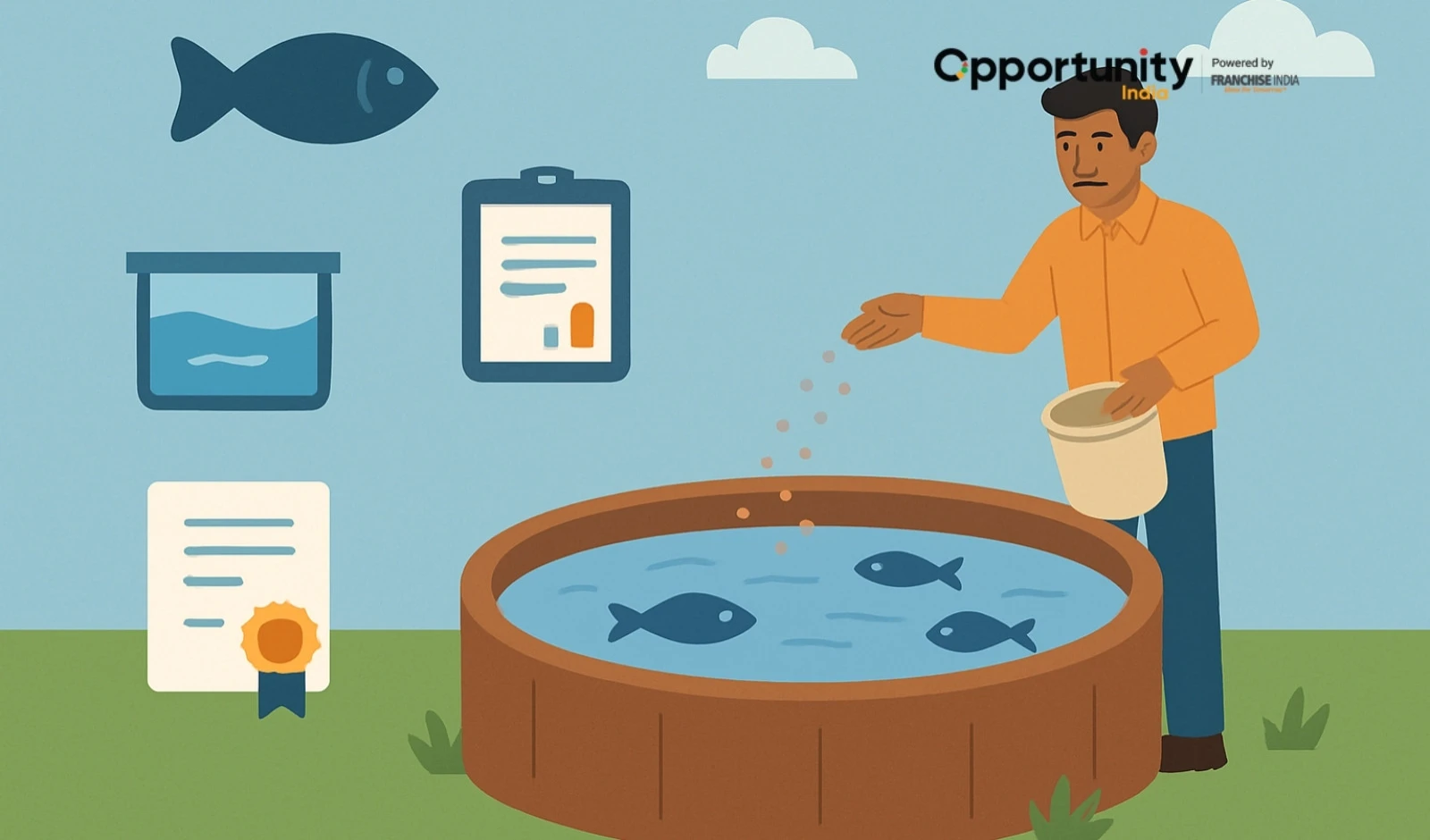
You're probably looking for fresh ways to make money if you're reading this, or perhaps you've always wanted to operate your fish farm. You're at the correct spot, either way. In India, fish farming is gaining popularity and not just among those who live close to rivers or the seaside. Anyone with a small amount of land, water, and a good plan may get started due to contemporary techniques and government assistance. Now, let's get started on the process of starting a fish farming business in India, step-by-step, with financial specifics and a realistic plan.
Why Fish Farming Business?
Aspiring fishermen will find India to be a rich ground due to its extensive coastline, plentiful freshwater resources, and growing demand for fish and seafood. Pisciculture, or fish farming, has become a very profitable industry with excellent returns on investment that promotes both economic growth and food security.
India is the world's second-largest producer of fish, and the country's fish farming sector is expanding quickly. Particularly in rural and semi-urban locations, fish farming offers entrepreneurs a great opportunity due to the growing demand for fish in both domestic and international markets.
Also Read: How To Set Up an AgriTech Business?
The size of the Indian fish market was 22.32 million tons in 2024, and by 2033, it had grown to 43.77 million tons at a compound annual growth rate (CAGR) of 7.38%. The industry has grown steadily due to increased disposable incomes, expanding export markets, and rising domestic demand. Its potential is further enhanced by government programs, technology developments, and a move toward sustainable behaviors.
For farmers, business owners, and anybody else trying to establish a reliable source of revenue, fish farming is more than simply a trend. The following explains why an increasing number of Indians are entering this industry:
High Demand, Expanding Industry
In many Indian homes, fish is a staple, particularly in Tamil Nadu, West Bengal, Kerala, Odisha, and Assam. Throughout the nation, it is also a significant source of protein.
- More than 60% of the fish produced in India is consumed.
- The demand for seafood in the US, Europe, and Southeast Asia is driving the export market's growth.
High Potential for Profit
If properly managed, fish farming can yield substantial profits.
- Less expensive inputs than dairy or poultry
- Quicker turnaround (pangasius and tilapia need 6–8 months to grow!)
- Several cycles per year are feasible.
- You can earn ₹1–2 lakh per acre per cycle with good management.
Start Small
- To begin, you don't need a lot of money or a lot of land.
- To start, a few tanks or a tiny pond will suffice.
- You can even use tanks or RAS in your backyard.
- Scalable—you can grow with it.
- Ideal for side hustlers, farmers, and newbies.
.jpg)
Government Support & Subsidies
The Indian government is aggressively advancing aquaculture with programs such as:
- Yojana PM Matsya Sampada (PMMSY)
- Up to 60% in subsidies for equipment, tanks, and infrastructure
- Simple loans from cooperative banks and NABARD
- You can get financial assistance to lessen the stress of starting a business.
Effective Resource Utilization
- One type of sustainable agriculture is fish farming.
- Less water-intensive than traditional crops like paddy
- Can be combined with other agricultural pursuits (such as raising crops or chickens).
- You can use fish feces as fertilizer.
- Resource-efficient and environmentally friendly.
Also Read: How To Get FSSAI License For a Home Kitchen Business?
Types of Fish Farming
Selecting the kind of fish farming plan that best fits your land, water supply, and financial capabilities is crucial before you begin:
a. Fish farming in ponds
- Perfect for open-land rural or semi-rural locations
- Low-cost, conventional approach
- Fit for fish in freshwater.
b. Recirculating aquaculture system, or tank
- Modern, space-efficient technique
- High-density manufacturing in regulated settings
- Perfect for indoor or urban environments
- High initial outlay but high output
c. Cage Culture Carried Out in Reservoirs, Rivers, or Lakes
- Needs approval from the local government.
- Medium yields at low capital costs
d. Integrated Fish Farming
- Mixes the production of fish with that of ducks, chickens, or crops.
- Increases earnings by making better use of waste
.jpg)
Step-by-Step Plan to Start Fish Farming in India
A solid business plan is essential to any successful endeavor. When it comes to fish farming, it should include:
Market Research and Feasibility Analysis
- Supply and Demand: Recognize the need for different fish species on a local, regional, and even national level. Determine supply shortages and evaluate the level of competition.
- Target Market: Who might purchase from you? Restaurants, lodging facilities, wholesalers, local markets, or even export companies? Your decision will affect the species you choose and the size of your operation.
- Favorite Species: Look into the most popular and profitable fish species in your target market. Consider their pace of growth, disease resistance, feed conversion ratio, and ability to adjust to local conditions.
- SWOT Analysis: Assess your company's opportunities, threats, weaknesses, and strengths.
Also Read: How to Start a Button Mushroom Farming Business?
Choosing Your Fish Farming Model
There are numerous models, each with advantages and disadvantages:
- Pond Fish Farming: The most conventional and widely used technique, appropriate for different sizes. It entails controlling water quality and digging earthen ponds.
- Cage Culture: Fish are raised in net cages hung in lakes, reservoirs, or rivers as part of the cage culture method. This works well in places where there are natural water sources.
- Recirculating Aquaculture Systems (RAS): A rigorously regulated process that recycles, filters, and repurposes water. This reduces water use and permits high stocking densities, making it frequently appropriate for land-constrained urban or semi-urban environments. One common kind of RAS is Biofloc technology.
- Integrated Fish Farming: Fish farming that is integrated with other agricultural pursuits, such as horticulture, cattle, or poultry, allows waste from one system to be utilized as input for another, resulting in a sustainable and economical environment.
- Ornamental Fish Farming: Aquatic fish breeding and sales are the main focus of ornamental fish farming, a specialized industry with healthy profit margins under the right management.
Site Selection: The Key to Achievement
The location is important. Think about the following:
- Water Source: It's critical to have consistent access to pure, uncontaminated water (from a borewell, river, canal, etc.). Check the temperature, dissolved oxygen content, and pH of the water.
- Soil Type: Clayey or loamy soil with a high water-retention capacity is best for pond farming.
- Topography: Water management and drainage are made easier by gently sloping terrain.
- Proximity to Market: Being close to the market guarantees the freshness of your produce and lowers transportation expenses.
- Electricity: It is necessary for aerators, pumps, and other devices.
- Accessibility: Simple access for moving harvested fish, fingerlings, and feed.
- Legal Compliance: Verify that the site complies with regional environmental and zoning rules.
Also Read: How to Start a Mushroom Farming Business?
Choosing the Right Fish Species
India has a wide variety of fish species that are good for aquaculture. Several well-liked options are:
- Indian Major Carps (IMC): Catla, Rohu, and Mrigal are Indian Major Carps (IMC) that grow quickly, are in great demand, and may be raised in polyculture (cultivating several species at once).
- Exotic Carps: Due to their quick development and versatility, common carp, silver carp, and grass carp are also commonly raised.
- Tilapia: Well-known for its high protein content, rapid growth rate, and ability to adapt to different water conditions. In biofloc systems, Monosex GIFT Tilapia is especially well-liked.
- Catfish: Pangasius and Magur are resilient species that can withstand reduced oxygen levels, which makes them appropriate for a variety of aquaculture setups.
- Others: Some freshwater species, like as mullet and pearl spot, are also grown, as are basa and trout (for cooler climates).
Your decision should take into account your farming model, the demand in the market, and the resources at your disposal.
Investment Required for Fish Farming in India (2025)
Here’s a rough estimate (for a small 1-acre pond farm):
| Item | Cost (INR) |
|---|---|
| Pond construction | ₹1,50,000 |
| Fingerlings (2,000) | ₹10,000 |
| Feed (6–8 months) | ₹60,000 |
| Equipment/tools | ₹15,000 |
| Labor | ₹30,000 |
| Misc. expenses | ₹20,000 |
| Total | ₹2.8–3.5 lakh |
For tank-based RAS farming, the cost goes up to ₹5–6 lakh—but so do your yields and control over production.
India's fish farming industry is one with enormous growth potential. You can start a successful and lucrative fish farming business by carrying out an in-depth study. You can create a solid business strategy, obtain the required capital, implement scientific methods, and successfully market your produce. It is important to be patient and willing to learn at every stage to build a profitable farming business.

